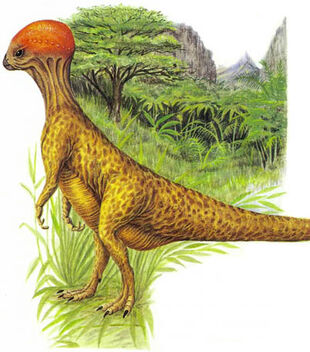
The Late Cretaceous pachycephalosaurs spread far and wide across the lands of the Northern Hemisphere. Many developed into new forms to exist in new environments (like with the gestalt) but some, like the numbskull, remained quite conservative.
The Numbskull, Sphaeracephalus riparus, is a tropical rainforest mountain-dwelling pachycephalosaur from the Kali Gandaki Gorge, in The New Dinosaurs: An Alternative Evolution.
The great Himalayan mountain range is young, but it is already deeply weathered and eroded. Annually, melting snows from the higher slopes and the constantly decaying glaciers produce torrents of water that form streams cascading from the heights towards the distant plains and the Indian Ocean. At the same time the mountain range is continually pushed upwards by the inexorable movements of the planet's crust. As the mountains rise, the river gorges deepen. This has led to an unusual circumstance, in which a major eastward-flowing river on the northern flanks of the range (the Gandaki River) has turned south and cut right across the mountain system to reach the sea in a mass of deltas to the south. Cutting through the range, it has formed a gorge (Kali Gandaki Gorge) that is the deepest on Earth. The lush vegetation that grows along the narrow banks of the Gandaki River in the depths of the gorge supports its own wildlife. The most typical animal is the numbskull, one of the pachycephalosaurs. It has changed very little since the group evolved in Late Cretaceous times, and it still pursues the same herbivorous lifestyle. It lives in herds and family groups in the Kali Gandaki Gorge, with the males periodically sparring with one another for leadership of the herd. The numbskull is bipedal and roams through the tropical forest found in the gorge, maintaining balance with the strong tail.
